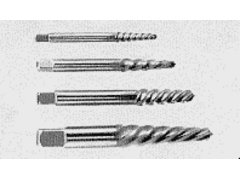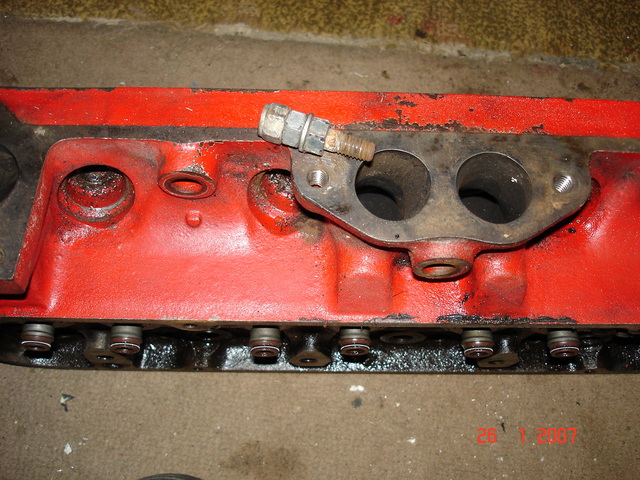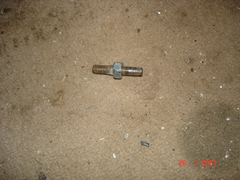02GF74
|
 posted on 26/1/07 at 09:51 AM posted on 26/1/07 at 09:51 AM |

|
|
another stud removal thread
Any other stuff I should try in order to remove a stud from a cast iron head?
Got one left to do, on the exhaust side and the threads on it are a bit worn.
I have done the penetrating oil thing, put on two 5/16 UNF nuts, done up tightly with a spring washer in between and heated the head with a blow torch
but no joy. 
Next on the attack plan is to heat the head up in an oven and do the blow torch thing again and if that fails, Mr Weldeer coomes out of hiding to
weld a nut on as the threads are beginning to go.
(at lunchtime I'll be buying the UNC taps for the inevitable  ). ).
Secondly is there any advantage in putting in M8 studs? (I've got enough UNF nuts) and going to stainless steel studs? I'm sure I can
get the bolts cheapish and then put the UNC thread on myselft but
a) how much harder will putting the thread on be compared to steel?
b) will the cast iron and stainless steel react?
b) with the heat cycling on the eaxhaust side weaken the stud?
So that should it ever need to be removed, it is more likely to snap than a
steel one? 
|
|
|
|
|
macnab
|
| posted on 26/1/07 at 10:01 AM |

|
|
heat the stud up till it glows and let it cool before drenching in WD40 it should then come out. Don't just cut it off, persevere it WILL come
out, just keep heating it up and trying again.
a)tapping threads in iron is easy, better than steel
b)no, I only use stainless bolts on exhausts
c)no
|
|
|
bartonp
|
| posted on 26/1/07 at 10:07 AM |

|
|
You could go the other way & use an electronics/plumbing freezer spray on the stud - maybe even in combination with heating the head.
|
|
|
02GF74
|
| posted on 26/1/07 at 10:12 AM |

|
|
quote:
Originally posted by macnab
a)tapping threads in iron is easy, better than steel
re: a), I was referring to put a thread on the stainless steel bolts (cut off the heads to make studs). From cutting/drilling stainless sheet, it is
a damn side harder than mild steel sheet.
|
|
|
RazMan
|
| posted on 26/1/07 at 10:13 AM |

|
|
Might be stating the obvious here but have you considered the Easy-out (sp?) left hand thread extractor tool thingy?
btw - using copper plated nuts on exhaust studs save a lot of this type of aggro 
[Edited on 26-1-07 by RazMan]
Cheers,
Raz
When thinking outside the box doesn't work any more, it's time to build a new box
|
|
|
02GF74
|
| posted on 26/1/07 at 10:17 AM |

|
|
quote:
Originally posted by RazMan
Might be stating the obvious here but have you considered the Easy-out (sp?) left hand thread extractor tool thingy?
Is hasn't broken off ....... YET.  Easy outs are the curse of satan, those are more likley to snap making it harder to drill out. Easy outs are the curse of satan, those are more likley to snap making it harder to drill out. 
I can slap the head onto my drill press and be confident I can drill centrally down in the the stud when it does break - ah - I see where you're
coming from - I mottied to mention the head is not on the engine.
re: heating the boss - is cast iron gonna be unahppy about localised heating - hence the oven idea?
|
|
|
oily85
|
| posted on 26/1/07 at 10:33 AM |

|
|
My dad told me about something on an aviation forum, a lot of Aircraft engineers use Tizer, the drink, for stud removal, they reckon there's
nothing better
|
|
|
macnab
|
| posted on 26/1/07 at 10:43 AM |

|
|
quote:
Originally posted by 02GF74
quote:
Originally posted by macnab
a)tapping threads in iron is easy, better than steel
re: a), I was referring to put a thread on the stainless steel bolts (cut off the heads to make studs). From cutting/drilling stainless sheet, it is
a damn side harder than mild steel sheet.
I use the bolts as bolts as they’re easier to remove than a stud. For example on my exhausts its stainless bolt, stainless washer and a brass nut. The
brass nut being tightened down onto the manifold once the bolts been screwed in about 15mm. With that you will never have any more problems with them
again.
[Edited on 26/1/07 by macnab]
|
|
|
02GF74
|
| posted on 26/1/07 at 11:29 AM |

|
|
ta for that idea ^^^ but I'll reserve any drilling once it has snapped so drill most of it out then; reduces rtisk of drills snapping.
oh, another thinkg I forgot to mention is that the boss is drilled right through so I can access the other end of the stud. I have scraped around it
and put some fluid on.
It seems the plan of heat/blow lamp -> weld nut is the way to go; then drill out once it has snapped.
|
|
|
Alan_Thomas
|
| posted on 26/1/07 at 11:34 AM |

|
|
quote:
Originally posted by RazMan
Might be stating the obvious here but have you considered the Easy-out (sp?) left hand thread extractor tool thingy?
I have a problem at the moment because I used an easyout which then broke and now the piece of broken easyout is preventing me doing what I should
have done in the first place, namely drill it out and use a helicoil if required. The 'Easyout' seems to be very badly named! 
|
|
|
David Jenkins
|
| posted on 26/1/07 at 11:36 AM |

|
|
They should be called "EasySnap"!
If all else fails, take it to a machine shop - they may be able to spark-erode it out for a small amount of cash.
David
|
|
|
Nick Skidmore
|
| posted on 26/1/07 at 11:44 AM |

|
|
TCT tipped masonary drills are the business for getting studs out.
You can get them in 0.5 mm increments so getting one close to the tapping size for 5/16 unf shouldn't be too hard.
|
NOTE:This user is registered as a LocostBuilders trader and may offer commercial services to other users
|
macnab
|
| posted on 26/1/07 at 12:06 PM |

|
|
quote:
Originally posted by Alan_Thomas
quote:
Originally posted by RazMan
Might be stating the obvious here but have you considered the Easy-out (sp?) left hand thread extractor tool thingy?
I have a problem at the moment because I used an easyout which then broke and now the piece of broken easyout is preventing me doing what I should
have done in the first place, namely drill it out and use a helicoil if required. The 'Easyout' seems to be very badly named! 
Those things are just sh$t. Just a HUGE BIG bad idea...
|
|
|
jollygreengiant
|
| posted on 26/1/07 at 01:51 PM |

|
|
If famale section is cast iron or steel then heat with Oxy/acet welding or cutting torch evenly around stud until item (but not stud) is cherry red
then fit mole grips to stud and undo.
JD.
Beware of the Goldfish in the tulip mines. The ONLY defence against them is smoking peanut butter sandwiches.
|
|
|
02GF74
|
| posted on 26/1/07 at 02:00 PM |

|
|
quote:
Originally posted by jollygreengiant
If female section is cast iron or steel then heat with Oxy/acet welding or cutting torch evenly around stud until item (but not stud) is cherry red
then fit mole grips to stud and undo.
JD.
yes it is - will cast iron like being heated up like that? (not that I will be able to with my puny blow lamp)
|
|
|
awinter
|
| posted on 26/1/07 at 02:09 PM |

|
|
stud extractor
Don't shout at me if I'm stating the obvious but.....
Have you used stud extractors? I have used them to good effect on stubborn studs in pug aluminium heads.
Allan
|
|
|
macnab
|
| posted on 26/1/07 at 02:38 PM |

|
|
stud extractors! i.e easy outs...
They should come with this written on them -
'WARNING!! 99% Chance off just Snapping and will require a Diamond drill to remove!'
Useless bloody things.
 
Rescued attachment easyout.gif
|
|
|
02GF74
|
| posted on 26/1/07 at 02:45 PM |

|
|
quote:
Originally posted by awinter
Have you used stud extractors? I have used them to good effect on stubborn studs in pug aluminium heads.
not sure if you mean the one#s that Devil Rik is referring to vvvvv, but there are some that operate via can action with an eccentric wheel i.e.:

(So no, I don't have one, plus I think, and I may be wrong) that the off-centre loading may snap if off sooner than later.
|
|
|
Phil.J
|
| posted on 26/1/07 at 03:17 PM |

|
|
Easy-outs are not realy meant to be used to remove siezed studs, just studs that are broken off flush or below the surface. If you have a broken drill
or easy-out on the stud, it may be best to have it spark eroded by someone with the right kit, works like magic!
ATB
Phil
|
|
|
BenB
|
| posted on 26/1/07 at 04:50 PM |

|
|
Or.... get some nice new drill bits and get drilling... you can drill through easy-outs with a bit of effort...
Mains drills spin a bit too fast- if you've got a variable speed drill then its a bit better but it's a pain keeping the speed stable...
Portable battery drills turn a bit slower but with a good amount of torque. I hardwired 12v up the chuff of a 9.6v drill and even with rather old bits
managed to drill out 10mm of a 5-6mm easyout in about 30 minutes...
|
|
|
farmer.palmer
|
| posted on 26/1/07 at 07:28 PM |

|
|
Heres a little known secret...
If you are a competent welder, go to your local welding supplies shop and buy a EutecTrode Xuper 680 S rod or similar, (these are for joining
disimilar metals and high carbon steels), and, another bolt or piece of steel of a similar diameter to that of the stuck stud.
Very carefully weld the bolt/steel to the stud at a 45 degree angle and let it cool completely (you can apply oil at this stage , it may help). You
can put it under a tap to cool it if you wish.
Once cool, get a small hammer or mallet and gently tap the bolt/steel back and forth and keep applying oil/WD40 etc, you should find that the stud
will become loose and undo. If you break off the welded on piece, then start again.
What happens is that the act of welding directly to the stud heats it up quicker that that of the surrounding material (you cannot do this with a gas
flame, and trying to unscrew a redhot stud normally results in a sheared off stud which is what you don't want.) and 'shocks' it,
causing the corrosion to loosen, letting it cool completely allows everything to return to normal and then the stud is 'free' and you now
have a lever to remove it with.
Works every time. I have removed studs that have sheared off below the level of the block before this way with some very careful welding.
The reason for using a special rod is that normal mild steel would not produce a weld that is strong enough, 680 rods are very easy to weld with , but
quite expensive....
good luck!
[Edited on 26/1/07 by farmer.palmer]
|
PLEASE NOTE: This user is a trader who has not signed up for the LocostBuilders registration scheme. If this post is advertising a commercial product or service, please report it by clicking here.
|
rusty nuts
|
| posted on 26/1/07 at 07:28 PM |

|
|
Use a proper stud remover . Got a klane one I use in a 1/2 air wrench . Works a bit like a chuck but the more torque applied the better it grips . If
stud breaks just drill and retap . Not all stud extractors are easiouts the best place for those are in the bin
|
|
|
johnjulie
|
| posted on 28/1/07 at 11:18 PM |

|
|
Heat is the way to go, it dissolves the rust
Get the stud at least cherry red, let it cool then use an extractor that fits in a socket wrench. Try tightening slightly, then anti clockwise in
small movements. With the right amount of heat it will come loose. A few taps on the end of the stud may help free it too!
Cheers J&J
JFDI
"Just F*****G Do It"
|
|
|
flak monkey
|
| posted on 29/1/07 at 07:17 AM |

|
|
Cast iron will be fine locally heated as long as you dont let it cool too quickly.
As others have said a bit of heat should get it out, if not drill it. Drilling studs out isnt particularly difficult, the worst bit is making sure you
hit the centre of the old stud.
David
Sera
http://www.motosera.com
|
|
|
02GF74
|
| posted on 29/1/07 at 09:25 AM |

|
|
Contrary to what I said I'd do, I wound on another nut (3 in all) and put a blow torch onto the manifold. Then using a mallet, smacket the
spanner and it started to move.
Using the two handed technique( TM) with spanner and socket, the stud finally came out. This all happened on Friday evening so a good start to the
weekend.
(fastener place was closed so didn;t get the stainless steel bolts  ) )
Here is the stud out (The cylinder head in now in BRG).
 
stud removed
An the stud showing the worn thread in the middle.
 
stud worn thread
|
|
|













